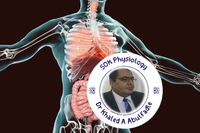| | Nerve & Muscle physiology Question & Answer by Dr Khaled A Abulfadle |  |
|
|
| كاتب الموضوع | رسالة |
|---|
admin
Admin

عدد المساهمات : 9680
تاريخ التسجيل : 06/08/2009
 |  موضوع: Nerve & Muscle physiology Question & Answer by Dr Khaled A Abulfadle موضوع: Nerve & Muscle physiology Question & Answer by Dr Khaled A Abulfadle  الخميس نوفمبر 05, 2015 5:43 am الخميس نوفمبر 05, 2015 5:43 am | |
|
عدل سابقا من قبل Admin في الأحد ديسمبر 10, 2017 9:46 am عدل 1 مرات | |
|
  | |
admin
Admin

عدد المساهمات : 9680
تاريخ التسجيل : 06/08/2009
 |  موضوع: رد: Nerve & Muscle physiology Question & Answer by Dr Khaled A Abulfadle موضوع: رد: Nerve & Muscle physiology Question & Answer by Dr Khaled A Abulfadle  الأربعاء مايو 04, 2016 7:30 pm الأربعاء مايو 04, 2016 7:30 pm | |
| | |
|
  | |
admin
Admin

عدد المساهمات : 9680
تاريخ التسجيل : 06/08/2009
 |  موضوع: رد: Nerve & Muscle physiology Question & Answer by Dr Khaled A Abulfadle موضوع: رد: Nerve & Muscle physiology Question & Answer by Dr Khaled A Abulfadle  الخميس مايو 11, 2017 12:51 pm الخميس مايو 11, 2017 12:51 pm | |
| Q: Vermicular contraction
=====
A: Vermicular contraction is characterized by being sluggish and lingering contraction. The presence of the vermicular contraction might be a sign of injury of the peripheral nervous system. So, it is contraction of denervated muscle
======================== | |
|
  | |
admin
Admin

عدد المساهمات : 9680
تاريخ التسجيل : 06/08/2009
 |  موضوع: رد: Nerve & Muscle physiology Question & Answer by Dr Khaled A Abulfadle موضوع: رد: Nerve & Muscle physiology Question & Answer by Dr Khaled A Abulfadle  الخميس أكتوبر 12, 2017 9:52 am الخميس أكتوبر 12, 2017 9:52 am | |
| | |
|
  | |
admin
Admin

عدد المساهمات : 9680
تاريخ التسجيل : 06/08/2009
 |  موضوع: رد: Nerve & Muscle physiology Question & Answer by Dr Khaled A Abulfadle موضوع: رد: Nerve & Muscle physiology Question & Answer by Dr Khaled A Abulfadle  الأحد ديسمبر 10, 2017 9:48 am الأحد ديسمبر 10, 2017 9:48 am | |
| | |
|
  | |
admin
Admin

عدد المساهمات : 9680
تاريخ التسجيل : 06/08/2009
 |  موضوع: رد: Nerve & Muscle physiology Question & Answer by Dr Khaled A Abulfadle موضوع: رد: Nerve & Muscle physiology Question & Answer by Dr Khaled A Abulfadle  الأحد يناير 28, 2018 5:12 pm الأحد يناير 28, 2018 5:12 pm | |
| Question
Why the accumulation of lactic acid lead to muscle fatigue ?
====
Answer
Very little lactic acid is produced in the muscles at rest and during very mild exercise and that which is produced can be removed quite readily so no excess accumulation occurs. However, when the production rate is high, as it usually is during most athletic contests, the mechanisms for removing lactic acid will be stressed to the limit and become incapable of removing all that is produced. This results in the accumulation of excess lactic acid in the muscles. As lactic acid accumulates in working muscles, their (the muscle’s) pH, which is normally slightly alkaline (7.04), will be reduced to some acidic value between 6.9 and 6.4 . When this happens, a condition called acidosis exists.
As acidosis progressed in muscles it supposedly slowed their contraction force and velocity so that their power output was reduced and athletes were no longer able to maintain a desired level of performance. Supposedly acidosis inhibits the activity of two rate limiting enzymes of metabolism, phosphorylase, which is involved in glycogenolysis), and phosphofructokinase (PFK). In addition, acidosis is thought to interfere with the release of calcium from the sarcoplasmic reticulum, which, in turn, reduces the amount that can bind with troponin on the actin molecule. This binding of calcium with troponin is believed to initiate muscular contraction by allowing the myosin cross bridges to bind with actin and exert an inward pull. Therefore, acidosis could conceivably reduce the contraction force of muscle fibers by both slowing the rate of ATP regeneration and by reducing the number and/or rate of formation of strong bonds between myosin and actin.
        | |
|
  | |
admin
Admin

عدد المساهمات : 9680
تاريخ التسجيل : 06/08/2009
 |  موضوع: رد: Nerve & Muscle physiology Question & Answer by Dr Khaled A Abulfadle موضوع: رد: Nerve & Muscle physiology Question & Answer by Dr Khaled A Abulfadle  الإثنين أكتوبر 08, 2018 8:53 pm الإثنين أكتوبر 08, 2018 8:53 pm | |
| | |
|
  | |
Hend Al-areqi
عدد المساهمات : 1
تاريخ التسجيل : 05/10/2019
 |  موضوع: Cell physiology موضوع: Cell physiology  السبت أكتوبر 05, 2019 5:46 pm السبت أكتوبر 05, 2019 5:46 pm | |
| Why mitochondrion DNA exist especially in mitochondrion not in the rest organelles | |
|
  | |
admin
Admin

عدد المساهمات : 9680
تاريخ التسجيل : 06/08/2009
 |  موضوع: رد: Nerve & Muscle physiology Question & Answer by Dr Khaled A Abulfadle موضوع: رد: Nerve & Muscle physiology Question & Answer by Dr Khaled A Abulfadle  الإثنين أكتوبر 07, 2019 8:57 pm الإثنين أكتوبر 07, 2019 8:57 pm | |
| | |
|
  | |
| | Nerve & Muscle physiology Question & Answer by Dr Khaled A Abulfadle |  |
|
